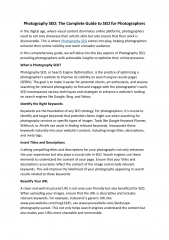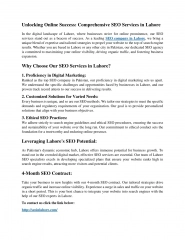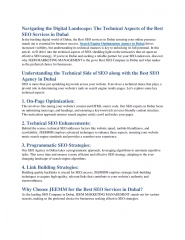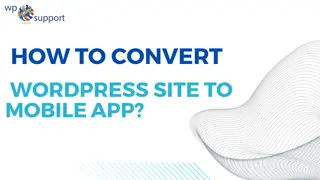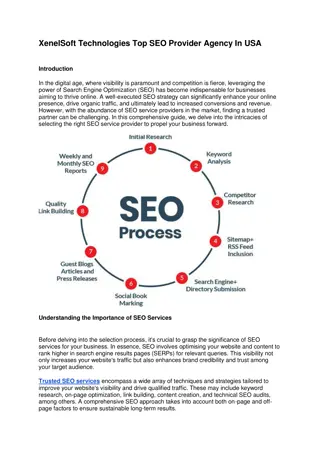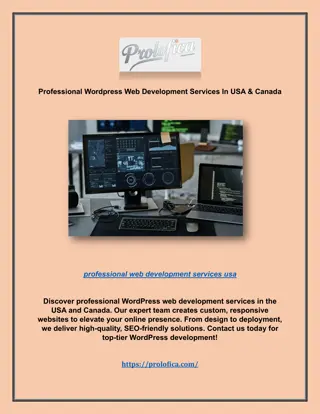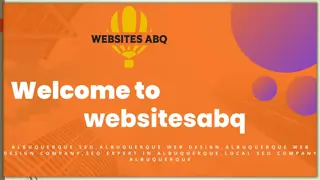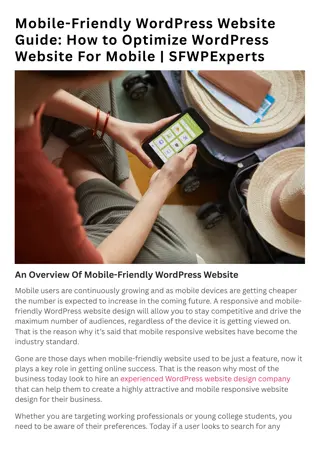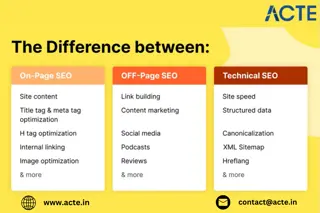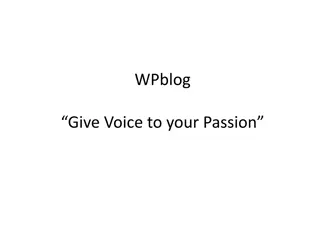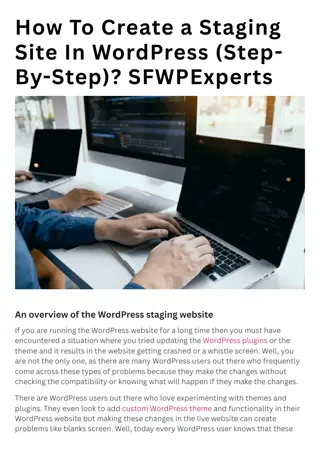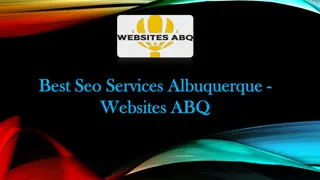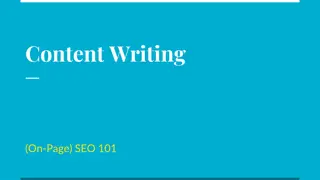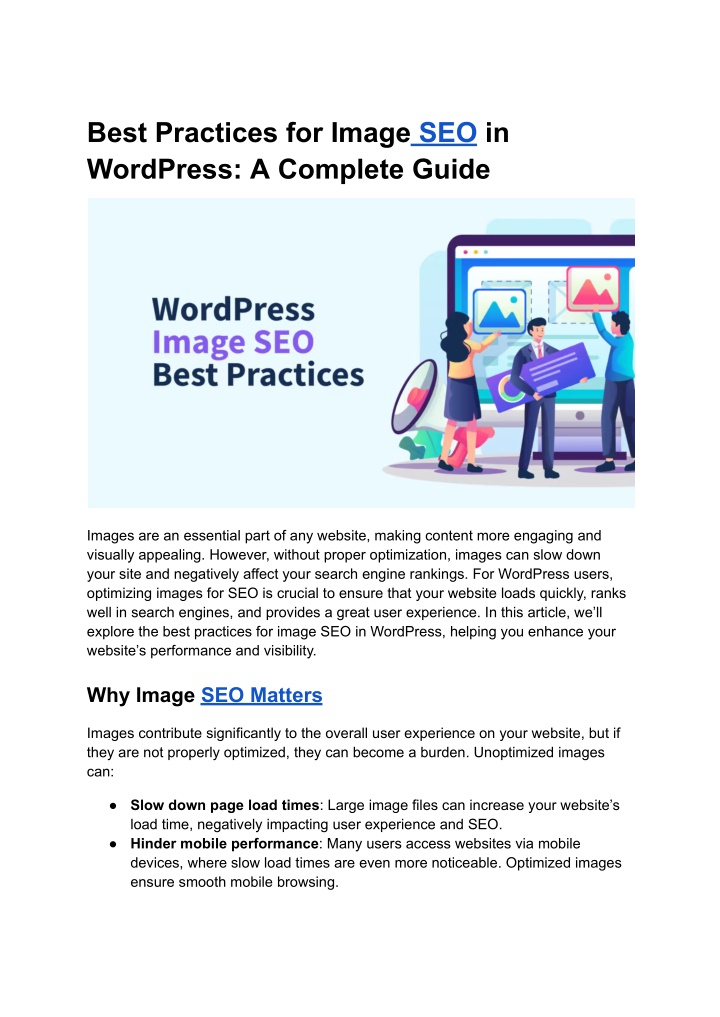
How to Optimize Images for SEO in WordPress_ A Complete Guide
How to Optimize Images for SEO in WordPress_ A Complete Guide
Download Presentation

Please find below an Image/Link to download the presentation.
The content on the website is provided AS IS for your information and personal use only. It may not be sold, licensed, or shared on other websites without obtaining consent from the author. If you encounter any issues during the download, it is possible that the publisher has removed the file from their server.
You are allowed to download the files provided on this website for personal or commercial use, subject to the condition that they are used lawfully. All files are the property of their respective owners.
The content on the website is provided AS IS for your information and personal use only. It may not be sold, licensed, or shared on other websites without obtaining consent from the author.
E N D
Presentation Transcript
Best Practices for Image SEO in WordPress: A Complete Guide Images are an essential part of any website, making content more engaging and visually appealing. However, without proper optimization, images can slow down your site and negatively affect your search engine rankings. For WordPress users, optimizing images for SEO is crucial to ensure that your website loads quickly, ranks well in search engines, and provides a great user experience. In this article, we ll explore the best practices for image SEO in WordPress, helping you enhance your website s performance and visibility. Why Image SEO Matters Images contribute significantly to the overall user experience on your website, but if they are not properly optimized, they can become a burden. Unoptimized images can: Slow down page load times: Large image files can increase your website s load time, negatively impacting user experience and SEO. Hinder mobile performance: Many users access websites via mobile devices, where slow load times are even more noticeable. Optimized images ensure smooth mobile browsing.
Limit accessibility and visibility: Search engines cant "see" images the way humans do, so without proper optimization, your images may not appear in search results, missing an opportunity to drive traffic. Optimizing images for SEO is about more than just reducing file size it s about making images more accessible, improving your site s speed, and helping search engines understand what your images represent. Best Practices for Image SEO in WordPress 1. Choose the Right Image File Format The format you choose for your images can have a significant impact on your website s performance. WordPress supports several image formats, but the most commonly used ones are: JPEG: Best for photographs and images with lots of colors and gradients. JPEGs offer high-quality images with relatively smaller file sizes. PNG: Ideal for images with transparency or sharp edges, such as logos or icons. PNG files are typically larger than JPEGs, so use them when necessary. WebP: A newer image format that provides excellent quality at smaller file sizes. It is supported by most modern browsers and is an excellent choice for improving page load times. GIF: Typically used for simple animations. It is not suitable for high-quality images due to its limited color palette. Choosing the right file format for your images will ensure a balance between quality and file size, improving your site s load times and user experience. 2. Compress Your Images Image compression is one of the most effective ways to reduce file sizes without sacrificing quality. Compressing images ensures faster load times, which is critical for both user experience and SEO. There are several tools available to compress images before uploading them to WordPress, including: TinyPNG: A popular online tool that compresses both PNG and JPEG images. ImageOptim: A Mac-based app that reduces file sizes without compromising quality. Smush: A popular WordPress plugin that automatically compresses images when you upload them, helping to maintain a fast website.
By compressing images, you can speed up your site and improve your rankings, as Google considers page speed as one of its ranking factors. 3. Use Descriptive File Names Search engines use image file names to understand what the image is about. Instead of using default names like "IMG1234.jpg," rename your image files with relevant, descriptive keywords that reflect the content of the image. For example: Bad example: IMG1234.jpg Good example: blue-widget-2019.jpg Including relevant keywords in your image file names helps search engines index your images properly and can improve your rankings in image search results. 4. Optimize Alt Text for Accessibility and SEO Alt text (alternative text) is used to describe images for both search engines and users who are visually impaired or use screen readers. It helps search engines understand what the image depicts and improves accessibility for people with disabilities. To optimize alt text: Be descriptive and concise: Explain what the image shows in a few words, incorporating relevant keywords without keyword stuffing. Avoid generic phrases: Phrases like "image" or "photo" don t help search engines or users understand the content. Use unique alt text for each image: Each image should have its own alt description that accurately reflects the image s content.
For more info https://blogizone.com/essential-image-seo-tips-for-wordpress-websites/

